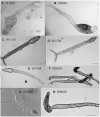An approach to revealing blood fluke life cycles, taxonomy, and diversity: provision of key reference data including DNA sequence from single life cycle stages
- PMID: 16629320
- PMCID: PMC2519025
- DOI: 10.1645/GE-3515.1
An approach to revealing blood fluke life cycles, taxonomy, and diversity: provision of key reference data including DNA sequence from single life cycle stages
Abstract
Revealing diversity among extant blood flukes, and the patterns of relationships among them, has been hindered by the difficulty of determining if specimens described from different life cycle stages, hosts, geographic localities, and times represent the same or different species. Persistent collection of all available life cycle stages and provision of exact collection localities, host identification, reference DNA sequences for the parasite, and voucher specimens eventually will provide the framework needed to piece together individual life cycles and facilitate reconciliation with classical taxonomic descriptions, including those based on single life cycle stages. It also provides a means to document unique or rare species that might only ever be recovered from a single life cycle stage. With an emphasis on the value of new information from field collections of any available life cycle stages, here we provide data for several blood fluke cercariae from freshwater snails from Kenya, Uganda, and Australia. Similar data are provided for adult worms of Macrobilharzia macrobilharzia and miracidia of Bivitellobilharzia nairi. Some schistosome and sanguinicolid cercariae that we recovered have peculiar morphological features, and our phylogenetic analyses (18S and 28S rDNA and mtDNA CO1) suggest that 2 of the new schistosome specimens likely represent previously unknown lineages. Our results also provide new insights into 2 of the 4 remaining schistosome genera yet to be extensively characterized with respect to their position in molecular phylogenies, Macrobilharzia and Bivitellobilharzia. The accessibility of each life cycle stage is likely to vary dramatically from one parasite species to the next, and our examples validate the potential usefulness of information gleaned from even one such stage, whatever it might be.
Figures



References
-
- Agatsuma T, Rajapakse RPVJ, Kuruwita VY, Iwagami M, Rajapakse RC. Molecular taxonomic position of the elephant schistosome, Bivitellobilharzia nairi, newly discovered in Sri Lanka. Parasitology International. 2004;53:69–75. - PubMed
-
- Attwood SW, Upatham ES, Meng XH, Qui D-C, Southgate VR. The phylogeography of Asian Schistosoma (Trematoda: Schistosomatidae) Parasitology. 2002;125:99–112. - PubMed
-
- Basch PF. Schistosomes: Development, reproduction and host relations. Oxford University Press; Oxford, U.K.: 1991. p. 248.
-
- Baugh SC. Contributions to our knowledge of digenetic trematodes VI. Zeitschrift für Parasitenkunde. 1963;22:303–315. - PubMed
-
- Bourgot R. Extension taxonomique et biogéographique du genre Hapalorhynchus (Trematoda, Spirorchidae) Bulletin de la Société Française de Parasitologie. 1990;8:289–294.
Publication types
MeSH terms
Substances
Associated data
- Actions
- Actions
- Actions
- Actions
- Actions
- Actions
- Actions
- Actions
- Actions
- Actions
- Actions
- Actions
- Actions
- Actions
- Actions
- Actions
- Actions
- Actions
- Actions
- Actions
- Actions
- Actions
- Actions
- Actions
- Actions
- Actions
- Actions
- Actions
- Actions
- Actions
- Actions
- Actions
- Actions
- Actions
- Actions
- Actions
- Actions
- Actions
- Actions
- Actions
Grants and funding
LinkOut - more resources
Full Text Sources
Molecular Biology Databases

